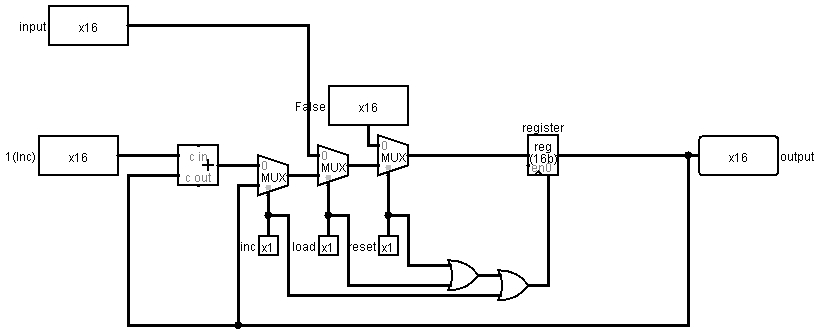PC Chip
1. PC Chip
The Program Counter (PC) is a 16-bit register with built-in control logic to support typical program counter operations: increment, load, and reset. It is used in the Hack computer to hold the address of the current instruction.
If reset = 1, the counter is reset to 0.
Else if load = 1, the counter is set to the input value.
Else if inc = 1, the counter is incremented by 1.
Otherwise, the counter holds its current value.

2. Truth Table
| in (16-bit) | load | inc | reset | out (16-bit) | Notes |
|---|---|---|---|---|---|
| x | 0 | 0 | 1 | 0000000000000000 | Reset to 0 |
| 0000000000001010 | 1 | 0 | 0 | 0000000000001010 | Load 10 |
| x | 0 | 1 | 0 | prev + 1 | Increment by 1 |
| x | 0 | 0 | 0 | previous value | Hold |
| 0000000000001111 | 1 | 1 | 0 | 0000000000001111 | Load overrides increment |
| x | 1 | x | 1 | 0000000000000000 | Reset overrides load and increment |
3. Implementation

4. Implementation (HDL)
The PC chip combines a Register, Inc16, and Mux16 chips to achieve its logic. Control signals are evaluated in the following priority: reset > load > inc.
CHIP PC {
IN in[16], load, inc, reset;
OUT out[16];
PARTS:
// Calculate next value with proper priority: reset > load > inc
Inc16(in=out, out=incOut);
Mux16(a=out, b=incOut, sel=inc, out=incOrHold);
Mux16(a=incOrHold, b=in, sel=load, out=loadOrInc);
Mux16(a=loadOrInc, b=false, sel=reset, out=nextPC);
// Register load signal: load if reset, load, or inc is active
Or(a=reset, b=load, out=loadOrReset);
Or(a=loadOrReset, b=inc, out=shouldLoad);
Register(in=nextPC, load=shouldLoad, out=out);
}